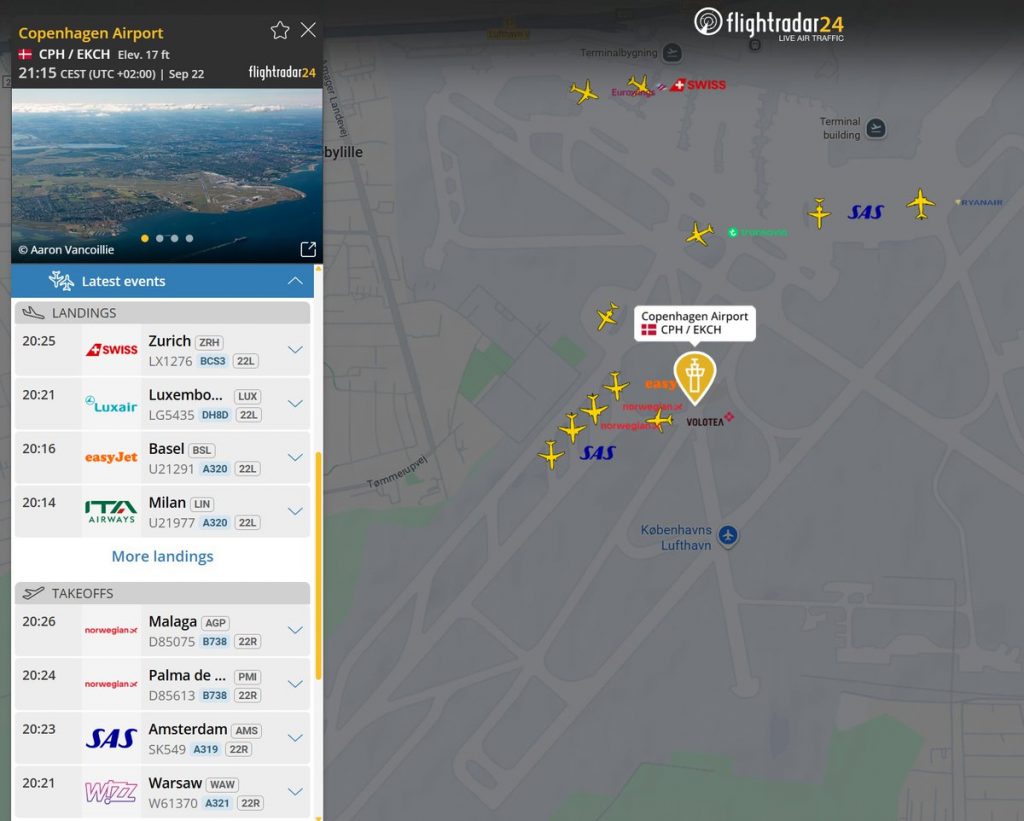
Russian Drones Near Copenhagen: Where Did They Come From?

Late evening, Copenhagen International Airport temporarily suspended operations. Air traffic controllers detected what appeared to be Russian drones near Copenhagen — several large UAVs that posed a threat to commercial aircraft. Departures were halted immediately. Flights bound for the Danish capital got diverted to alternate airports.
As we know, such “obstacles” can stop civilian but not military aircraft. Yet here’s the catch: military aircraft never showed up at the scene. No air defense response was observed either. According to press reports, the drones disappeared from the airport vicinity in an unknown direction. In other words, there was absolutely no military reaction to these events. If so, this incident can conditionally be called “Estonia-2.”
Where Russian Drones Near Copenhagen?
So far, no detailed description of the “large drones” has emerged. Perhaps these were long-range machines, the so-called “strategic UAVs,” capable of staying airborne for extended periods and covering thousands of kilometers. However, in that case, systems would have tracked them along their route from the launch site. Polish and Swedish air defense would have spotted them if launched from Kaliningrad Oblast.
By the way, Poland has already officially stated at the UN that it will shoot down, without warning or ceremony, all aerial targets entering its airspace. Sweden made the same statement following Poland. Logic suggests such declarations aren’t made on empty grounds. At minimum, air defense systems now stand on heightened alert. Therefore, “large drones” flying over the Baltic to Copenhagen while remaining undetected had zero chance.
A more likely scenario involves lighter-class drones, though they could hardly have reached the airport from Kaliningrad Oblast territory either. Plus, a Shahed-136 class drone would still get detected by air defense systems if flying far enough. Especially over the flat surface of the sea. Military vessels from coastal nations now constantly patrol the Baltic Sea. Poland and Sweden are currently conducting joint naval exercises. Undoubtedly, the radar systems of ships participating in the maneuvers should have detected the drones’ flight.
The Shadow Fleet Hypothesis
If nothing of the sort happened, suspicion arises. The drones might have launched from aboard a commercial vessel—for example, one belonging to Pootin’s “shadow fleet.” Any of these 940 aging tankers departing from Russian ports in Kaliningrad, Ust-Luga, Primorsk, or Petersburg could launch a number of drones and, after their mission is complete, retrieve them back onboard. If the Russians have indeed started doing such things, we must understand that the threat is spreading across the world like gas gangrene, and it’s time to do something about it.
And we remember Estonia’s and Finland’s plans to revoke their voluntary decisions to narrow their own territorial waters in the Gulf of Finland, which created a neutral water channel for Russian vessels and warships to pass without inspection. Perhaps it’s time to return to this topic in practical terms. Even if this incident had some other nature and doesn’t fit these two scenarios, such a possibility will inevitably get realized.
Overall, NATO has missed another goal. The Russian drones near Copenhagen incident exposed Denmark’s lack of adequate response. It shows the true level of complacency among the Alliance’s “inland” countries that don’t share borders with the swamps. Denmark, though a small country, has excellent air forces, navy, and air defense. In technical terms, it’s “equipped” at the highest level. But when it comes to the resolve to use all this excellent weaponry—it’s a failure.
Related posts:


Drones strike Shatura GRES in Moscow Region
Today, numerous friendly birds visited Shatura GRES in the Moscow region. Local Spielbergs don’t just film videos about their GRES but also comment on what’s happening. Obviously, they [...]
Drone Downs Helicopter 200km Deep in Russia
Special Operations Forces sometimes treat us to videos they post with practically no comments. They leave them for connoisseurs or those who have time and inspiration to pay [...]
